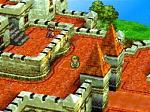Games Database
PlayStation
Adventure: Role Playing
| Viewed: | 2.5D Combination | Genre: | Adventure: Role Playing |
| Arcade origin: | No | ||
| Developer: | Enix | Soft. Co.: | Enix |
| Publishers: | Enix
(JP) |
Released: | 2000
(JP) |
Summary
The days of the text-based role-playing game are now long gone in the history of what is now a graphics-orientated industry. While a platform’s graphical capabilities are often the fuel for the development of many games, the role-playing genre is still focused primarily around gameplay. Enix’s Dragon Quest VII is probably the largest role-playing franchise next to Final Fantasy and Zelda, and after many delays it finally managed to hit the shelves, selling four million copies in the process. Fortunately, Dragon Quest’s delays are due to Enix tweaking gameplay attributes as opposed to visual improvements.
As befits the seventh title in the series, DQ7 is the most visually enhanced game, and although it doesn’t rival most software on the PlayStation, it has been developed in full 3D with reasonable camera controls that make it easy to play. Typical of the Japanese role-playing game is another world that is split into two distinct environments – field and battle. The two are completely separate in DQ7 and involve different gameplay approaches. While searching through towns, and talking to unplayable characters is strictly exploratory-based, the game’s battle arenas give players plenty of on screen action that can be demonstrated through the use of magic spells amongst other things. The game’s menu system plays an integral part that allows players to view their inventory, set abilities and check statistics with relative ease. Save points are also of vital importance and should be used with extreme caution, since the next scene could place you in a difficult position, especially in the battlefield. If your character’s levels are not high enough or they are not experienced enough, defeating the opposition may be impossible.
Enix’s decision not to release Dragon Quest 7 in PAL territories is mainly due to the hardcore nature of the game that many players will not appreciate. However, it remains a classic game that many role-playing fans will be disappointed not to see.
As befits the seventh title in the series, DQ7 is the most visually enhanced game, and although it doesn’t rival most software on the PlayStation, it has been developed in full 3D with reasonable camera controls that make it easy to play. Typical of the Japanese role-playing game is another world that is split into two distinct environments – field and battle. The two are completely separate in DQ7 and involve different gameplay approaches. While searching through towns, and talking to unplayable characters is strictly exploratory-based, the game’s battle arenas give players plenty of on screen action that can be demonstrated through the use of magic spells amongst other things. The game’s menu system plays an integral part that allows players to view their inventory, set abilities and check statistics with relative ease. Save points are also of vital importance and should be used with extreme caution, since the next scene could place you in a difficult position, especially in the battlefield. If your character’s levels are not high enough or they are not experienced enough, defeating the opposition may be impossible.
Enix’s decision not to release Dragon Quest 7 in PAL territories is mainly due to the hardcore nature of the game that many players will not appreciate. However, it remains a classic game that many role-playing fans will be disappointed not to see.





